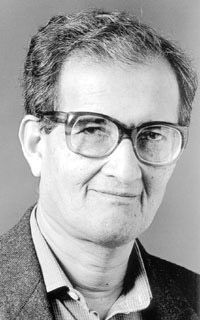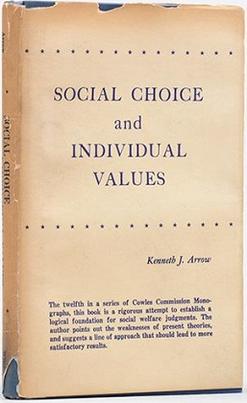Arrow's impossibility theorem, the general possibility theorem or Arrow's paradox is an impossibility theorem in social choice theory that states that when voters have three or more distinct alternatives (options), no ranked voting electoral system can convert the ranked preferences of individuals into a community-wide ranking while also meeting the specified set of criteria: unrestricted domain, non-dictatorship, Pareto efficiency, and independence of irrelevant alternatives. The theorem is often cited in discussions of voting theory as it is further interpreted by the Gibbard–Satterthwaite theorem. The theorem is named after economist and Nobel laureate Kenneth Arrow, who demonstrated the theorem in his doctoral thesis and popularized it in his 1951 book Social Choice and Individual Values. The original paper was titled "A Difficulty in the Concept of Social Welfare".
The independence of irrelevant alternatives (IIA), also known as binary independence or the independence axiom, is an axiom of decision theory and the social sciences that describes a necessary condition for rational behavior. The axiom says that adding "pointless" (rejected) options should not affect behavior. This is sometimes explained with a short story by philosopher Sidney Morgenbesser:
Morgenbesser, ordering dessert, is told by a waitress that he can choose between blueberry or apple pie. He orders apple. Soon the waitress comes back and explains cherry pie is also an option. Morgenbesser replies "In that case, I'll have blueberry."
The Gibbard–Satterthwaite theorem is a theorem in voting theory. It was first conjectured by the philosopher Michael Dummett and the mathematician Robin Farquharson in 1961 and then proved independently by the philosopher Allan Gibbard in 1973 and economist Mark Satterthwaite in 1975. It deals with deterministic ordinal electoral systems that choose a single winner. It states that for every voting rule, one of the following three things must hold:
- The rule is dictatorial, i.e. there exists a distinguished voter who can choose the winner; or
- The rule limits the possible outcomes to two alternatives only; or
- The rule is susceptible to tactical voting: in certain conditions, a voter's sincere ballot may not best defend their opinion.
The random ballot, single stochastic vote, or lottery voting is an electoral system in which an election is decided on the basis of a single randomly selected ballot.

The liberal paradox, also Sen paradox or Sen's paradox, is a logical paradox proposed by Amartya Sen which shows that no means of aggregating individual preferences into a single, social choice, can simultaneously fulfill the following, seemingly mild conditions:
- The unrestrictedness condition, or U: every possible ranking of each individual's preferences and all outcomes of every possible voting rule will be considered equally,
- The Pareto condition, or P: if everybody individually likes some choice better at the same time, the society in its voting rule as a whole likes it better as well, and
- Liberalism, or L : all individuals in a society must have at least one possibility of choosing differently, so that the social choice under a given voting rule changes as well. That is, as an individual liberal, anyone can exert their freedom of choice at least in some decision with tangible results.

Kenneth Arrow's monograph Social Choice and Individual Values and a theorem within it created modern social choice theory, a rigorous melding of social ethics and voting theory with an economic flavor. Somewhat formally, the "social choice" in the title refers to Arrow's representation of how social values from the set of individual orderings would be implemented under the constitution. Less formally, each social choice corresponds to the feasible set of laws passed by a "vote" under the constitution even if not every individual voted in favor of all the laws.
In social choice theory, unrestricted domain, or universality, is a property of social welfare functions in which all preferences of all voters are allowed. Intuitively, unrestricted domain is a common requirement for social choice functions, and is a condition for Arrow's impossibility theorem.

Arunava Sen is a professor of economics at the Indian Statistical Institute. He works on Game Theory, Social Choice Theory, Mechanism Design, Voting and Auctions.
Maximal lotteries refers to a probabilistic voting system first considered by the French mathematician and social scientist Germain Kreweras in 1965. The method uses preferential ballots and returns so-called maximal lotteries, i.e., probability distributions over the alternatives that are weakly preferred to any other probability distribution. Maximal lotteries satisfy the Condorcet criterion, the Smith criterion, polynomial runtime, and probabilistic versions of reinforcement, participation, and independence of clones.
Rental harmony is a kind of a fair division problem in which indivisible items and a fixed monetary cost have to be divided simultaneously. The housemates problem and room-assignment-rent-division are alternative names to the same problem.
In economics, dichotomous preferences (DP) are preference relations that divide the set of alternatives to two subsets: "Good" versus "Bad".
Fair random assignment is a kind of a fair division problem.
Random priority (RP), also called Random serial dictatorship (RSD), is a procedure for fair random assignment - dividing indivisible items fairly among people.
A simultaneous eating algorithm(SE) is an algorithm for allocating divisible objects among agents with ordinal preferences. "Ordinal preferences" means that each agent can rank the items from best to worst, but cannot (or does not want to) specify a numeric value for each item. The SE allocation satisfies SD-efficiency - a weak ordinal variant of Pareto-efficiency (it means that the allocation is Pareto-efficient for at least one vector of additive utility functions consistent with the agents' item rankings).
In the fields of mechanism design and social choice theory, Gibbard's theorem is a result proven by philosopher Allan Gibbard in 1973. It states that for any deterministic process of collective decision, at least one of the following three properties must hold:
- The process is dictatorial, i.e. there exists a distinguished agent who can impose the outcome;
- The process limits the possible outcomes to two options only;
- The process is open to strategic voting: once an agent has identified their preferences, it is possible that they have no action at their disposal that best defends these preferences irrespective of the other agents' actions.
Fractional social choice is a branch of social choice theory in which the collective decision is not a single alternative, but rather a weighted sum of two or more alternatives. For example, if society has to choose between three candidates: A B or C, then in standard social choice, exactly one of these candidates is chosen, while in fractional social choice, it is possible to choose "2/3 of A and 1/3 of B". A common interpretation of the weighted sum is as a lottery, in which candidate A is chosen with probability 2/3 and candidate B is chosen with probability 1/3. Due to this interpretation, fractional social choice is also called random social choice, probabilistic social choice, or stochastic social choice. But it can also be interpreted as a recipe for sharing, for example:
Fractional approval voting is an electoral system using approval ballots, in which the outcome is fractional: for each alternative j there is a fraction pj between 0 and 1, such that the sum of pj is 1. It can be seen as a generalization of approval voting: in the latter, one candidate wins and the other candidates lose. The fractions pj can be interpreted in various ways, depending on the setting. Examples are:
A school-choice mechanism is an algorithm that aims to match pupils to schools in a way that respects both the pupils' preferences and the schools' priorities. It is used to automate the process of school choice. The most common school-choice mechanisms are variants of the deferred-acceptance algorithm and random serial dictatorship.
Budget-proposal aggregation (BPA) is a problem in social choice theory. A group has to decide on how to distribute its budget among several issues. Each group-member has a different idea about what the ideal budget-distribution should be. The problem is how to aggregate the different opinions into a single budget-distribution program.
The median voting rule is a rule for group decision-making along a one-dimesional spectrum. An example is members of a city-council who have to decide on the total amount of annual city budget. Another example is several people working in the same office who have to decide on the air-conditioning temperature. Each member has in mind an ideal amount, and prefers the actual amount to be as close as possible to his peak.



